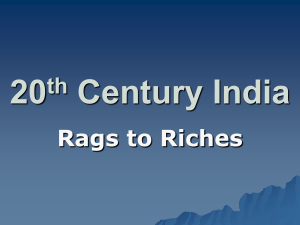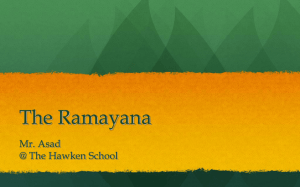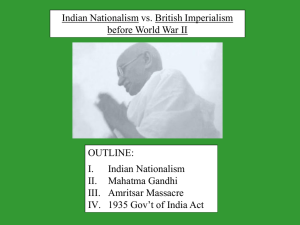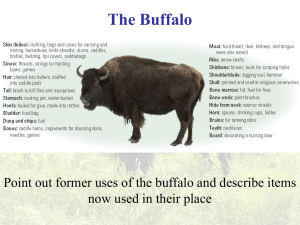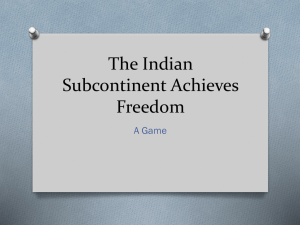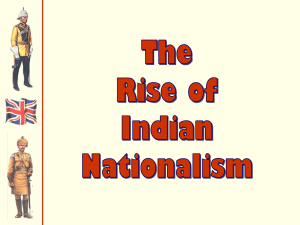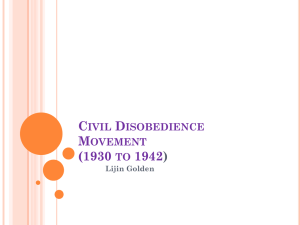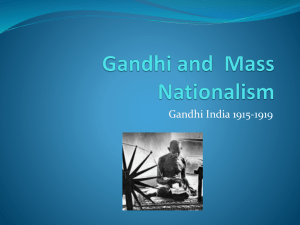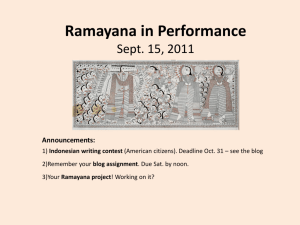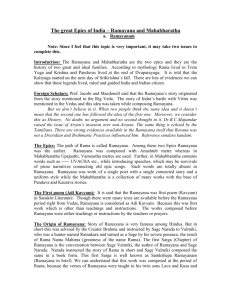Reflection Paper Moxley final
advertisement
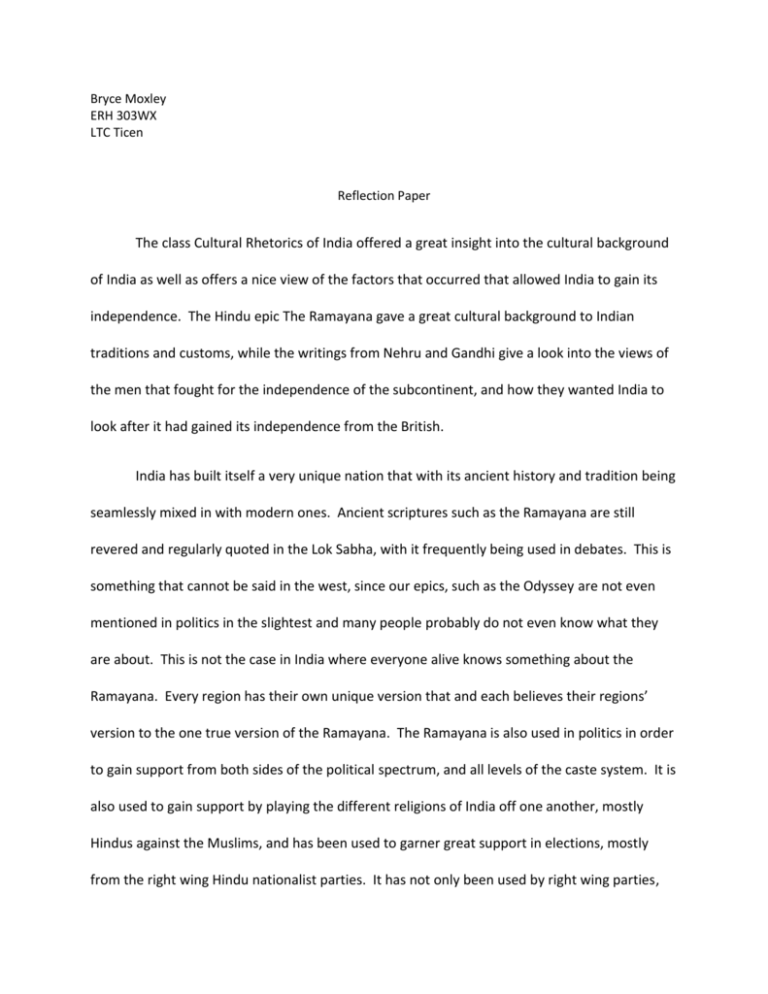
Bryce Moxley ERH 303WX LTC Ticen Reflection Paper The class Cultural Rhetorics of India offered a great insight into the cultural background of India as well as offers a nice view of the factors that occurred that allowed India to gain its independence. The Hindu epic The Ramayana gave a great cultural background to Indian traditions and customs, while the writings from Nehru and Gandhi give a look into the views of the men that fought for the independence of the subcontinent, and how they wanted India to look after it had gained its independence from the British. India has built itself a very unique nation that with its ancient history and tradition being seamlessly mixed in with modern ones. Ancient scriptures such as the Ramayana are still revered and regularly quoted in the Lok Sabha, with it frequently being used in debates. This is something that cannot be said in the west, since our epics, such as the Odyssey are not even mentioned in politics in the slightest and many people probably do not even know what they are about. This is not the case in India where everyone alive knows something about the Ramayana. Every region has their own unique version that and each believes their regions’ version to the one true version of the Ramayana. The Ramayana is also used in politics in order to gain support from both sides of the political spectrum, and all levels of the caste system. It is also used to gain support by playing the different religions of India off one another, mostly Hindus against the Muslims, and has been used to garner great support in elections, mostly from the right wing Hindu nationalist parties. It has not only been used by right wing parties, however, it was used by Gandhi during his non-violent fight against the British for the Independence of India to try and rally the diverse people of India together. The Ramayana Time Capsule project allowed me and helped me learn about how the Ramayana played such an important role in the politics and culture of India, by allowing a greater hands-on research experience with such an important piece of literature. Also by looking at other people’s presentations on different topics that were related the Ramayana, allowing me to have a greater view on all the ways that the Ramayana has been used and how loved across the subcontinent by politicians and the people alike. This includes learning about how art in India has been influenced by it to just how it has been used by politicians across the different ages of the existence of India has allowed for a greater understanding of the culture of India as a whole. This goes from the ancient past when the Ramayana was written, and used as a template for how kings to rule, to the modern times when it is being used to gain votes through religious differences and hatred. The next pieces of information that better helped understand the concepts of the culture of India and the factors that were driving India towards its independence were the readings from the writings of Nehru and Gandhi. These writings allow you get a feel for the two great leaders and their struggle for the independence of India from British rule. These two writings allow for the people who are trying to understand the politics of India directly after independence and right after partition, and to get a detailed look into how the politics of these two men would influence that nation more than any other men in the history of India. Gandhi in his writings, especially Indian Home Rule, shows a man that wants to reject the cultural and industrial improvements that the British brought with them to India, such as the hospitals and the railroads. Gandhi wanted to do this so that the people of India could establish a Hindustan, and not an Anglistan, with Anglistan being a nation with a Hindu veneer, with most of their traditions and culture being from the British. Gandhi wanted to have a nation that would have its own unique Indian culture that would be different from any other nation in the world and that would be unique to the nation of India and India alone. He also was highly active in the social policies of India, with him advocating very fervently for the abolishment of untouchability, which he called people who were doomed to this existence the “children of god.” Gandhi also vastly opposed the partition of India and called for the country not to be split into two as he believed that Hindus, Muslims, and Sikhs, could love together in harmony as they had done for centuries in India. These views are very strongly known in the book that was written by Gandhi, Indian Home Rule, which laid out a plan for how India was going to become independent, with Gandhi calling for a plan that would progress slowly and would not involve industrialization or any of the British imports to India that he believed was poisoning Indian society. Nehru on the other hand politically was almost the completely opposite from Gandhi on how India should gain independence and what it should do after such independence should be achieved. Nehru calls for independence now rather than later, calling himself impatient in his book, The Discovery of India. The expert from this book that was read in class shows Nehru as someone completely different from Gandhi, Nehru was a man who believed that the future of India relied best on industrialization and the adoption of western political and economic systems, such as socialism from the Soviet Union, would be the best thing that would allow India to flourish after its independence. Nehru also did not call for any radical social reforms, he did not try to reform the caste system, nor did he advocate any real change to the system, probably so that he could avoid alienating anyone and garner the maximum amount of support possible. In this way through Nehru’s writing it is easier to tell that he functioned more like a professional politician than Gandhi, giving me a better understanding of the way how two of India’s greatest leaders influenced the nation after independence. This class and the reading and cultural assignments that I had to accomplish, such as the readings from Gandhi and Nehru, and The Ramayana time capsule, allowed me a better understanding of the culture of India as a whole. I went into this class knowing some things about India and I came out with a much deeper understanding of the culture of the nation through learning about the readings of its great leaders and through their religious and cultural texts. I have greatly expanded my understanding of a different culture, and I believe that this will benefit me greatly in this more multi-cultural and connected world.
